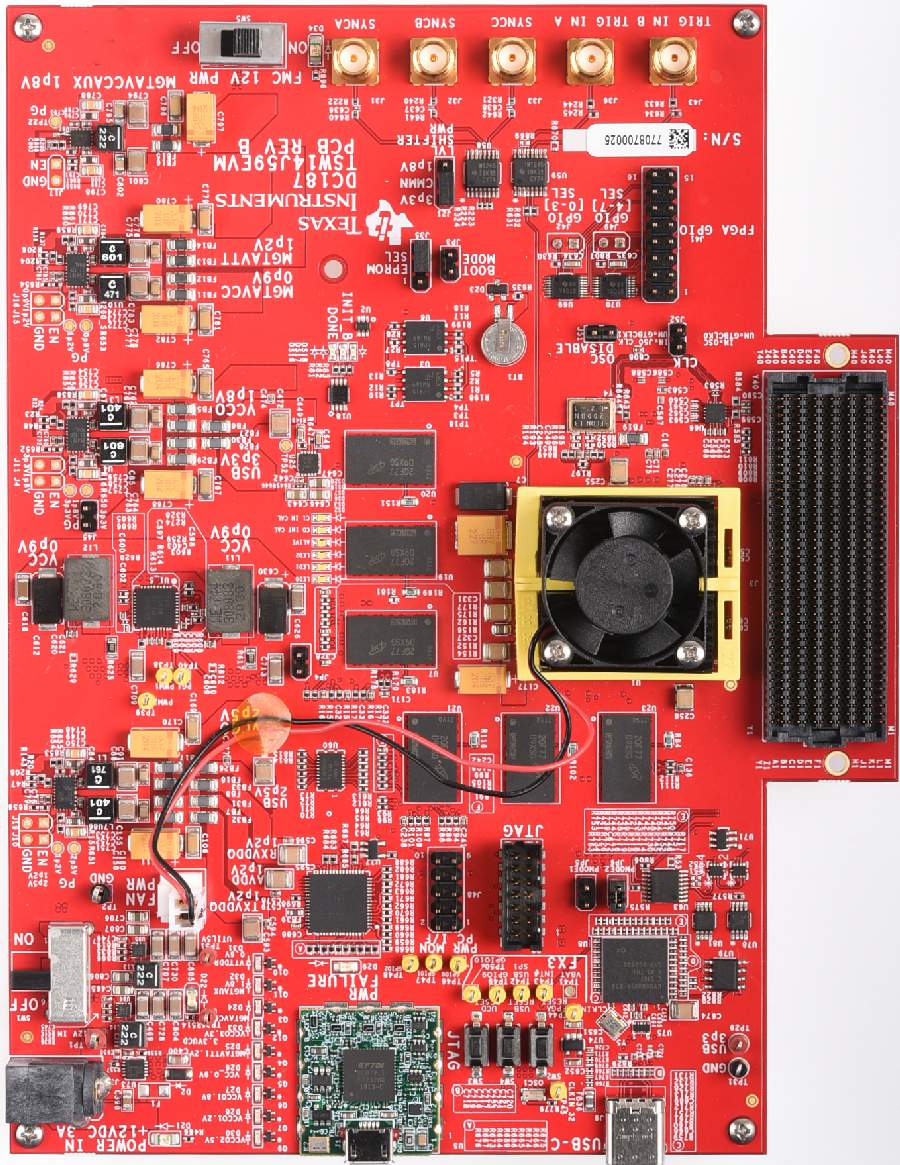SLWU095 april 2023
2 Functionality
The TSW14J59EVM has a single industry standard FMC+ connector that interfaces directly with TI JESD204B/C ADC, DAC, and AFE EVMs. The FMC+ carrier connector is compatible with the FMC mezzanine connector. When used with an ADC EVM, high-speed serial data is captured, deserialized and formatted by a Xilinx®Kintex®UltraScale® + FPGA. The data is then stored into an external DDR4 memory bank, enabling the TSW14J59 to store up to 1.536G, 16-bit data samples. To acquire data on a host PC, the FPGA reads the data from memory and transmits on a high-speed 32-bit parallel interface. An on-board high-speed USB 3.0 to parallel converter bridges the FPGA interface to the host PC and GUI.
In pattern generator mode, the TSW14J59 generates the desired test patterns for DAC EVMs under test. These patterns are sent from the host PC over the USB interface to the TSW14J59. The FPGA stores the data received into the board DDR4 memory module. The data from memory is then read by the FPGA and transmitted to a DAC EVM across the FMC+ interface connector. The board contains two 200-MHz oscillators used to generate the DDR4 reference clock and a general purpose clock. Figure 2-1 shows the TI TSW14J59 evaluation module.
 Figure 2-1 TSW14J59EVM
Figure 2-1 TSW14J59EVMThe major features of the TSW14J59 are:
- Backward-compatible with JESD204B (Subclasses: 0, 1, 2)
- Support for deterministic latency
- Serial lanes speeds up to 32Gbps
- 16 routed transceiver channels
- 24Gb DDR4 SDRAM (split into two banks of 3 independent 256 × 16, 4Gb SDRAMs). Quarter rate DDR4 controllers supporting up to 1200-MHz operation
- 1.536G of 16-bit samples of on-board memory
- Supports 1.8-V CMOS IO standard for spare FMC+ signals
- General purpose 200-MHz oscillator
- On-board Cypress USB FX3 USB 3.0
device for parallel interface to the FPGA
and general purpose I/O interface to on-board functions and FMC+
- On-board Digilent JTAG SMT2 programmer for FPGA JTAG interface for downloading firmware
- Reference clocking for transceivers available through FMC+ port or SMAs
- Supported by TI HSDC PRO software
- FPGA firmware developed with
Xilinx Vivado development tool.
- TI JESD RX IP core with
support for:
- USB and JTAG reconfigurable JESD core parameters: L, M, K, F, HD, S, and more
- ILA configuration data accessible through USB and JTAG
- Lane alignment and character replacement enabled or disabled through USB and JTAG
- TI JESD TX IP core with
support for:
- USB and JTAG reconfigurable JESD core parameters: L, M, K, F, HD, S, and more
- ILA configuration data accessible through USB and JTAG
- Dynamically reconfigurable Transceiver data rate.
- Serial lane operating range from 1 to 32Gbps
- TI JESD RX IP core with
support for:
Figure 2-2 shows a block diagram of the TSW14J59 EVM.
 Figure 2-2 TSW14J59EVM Block
Diagram
Figure 2-2 TSW14J59EVM Block
Diagram